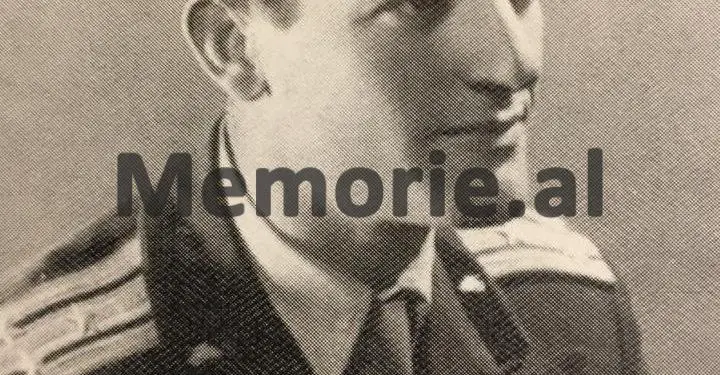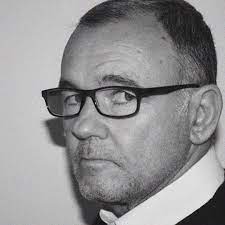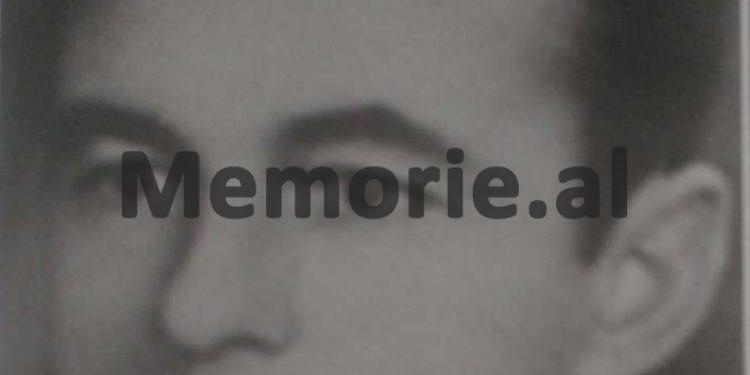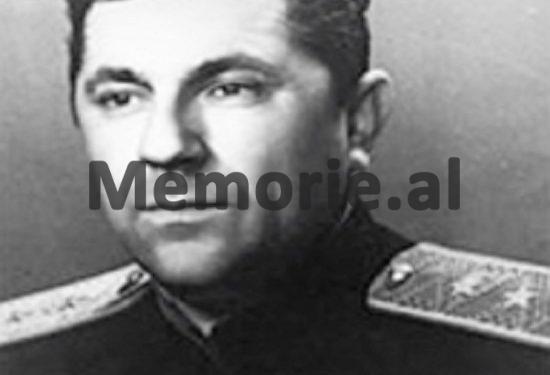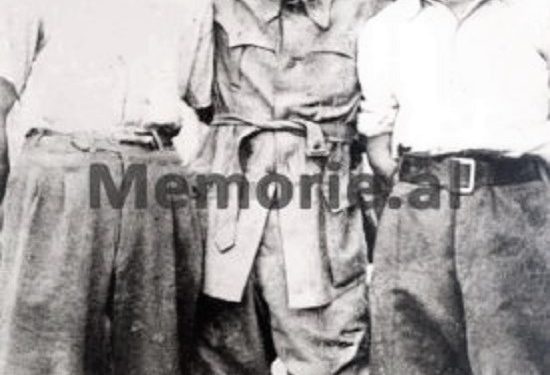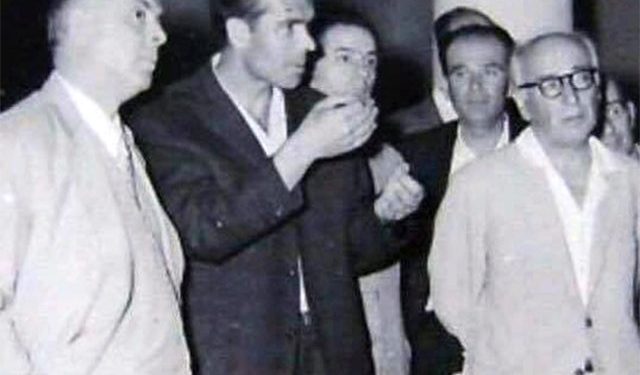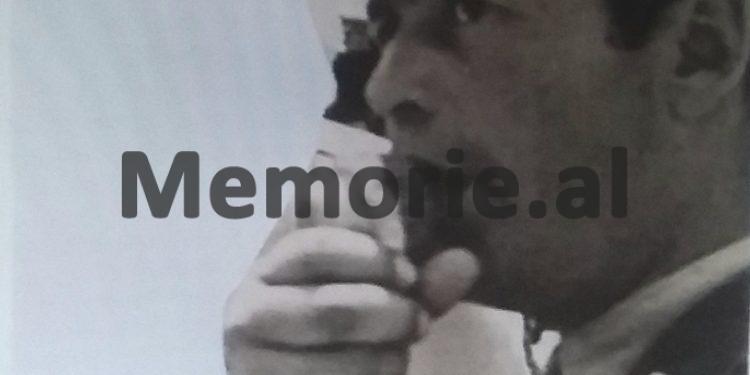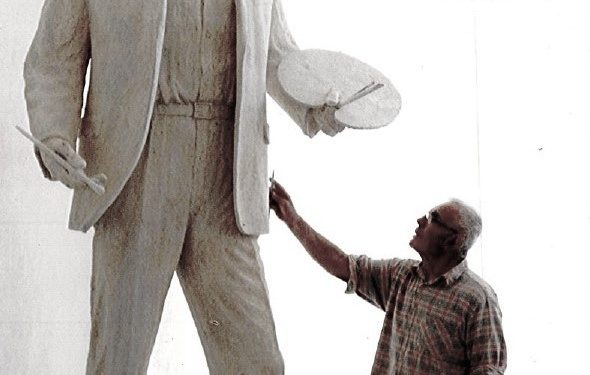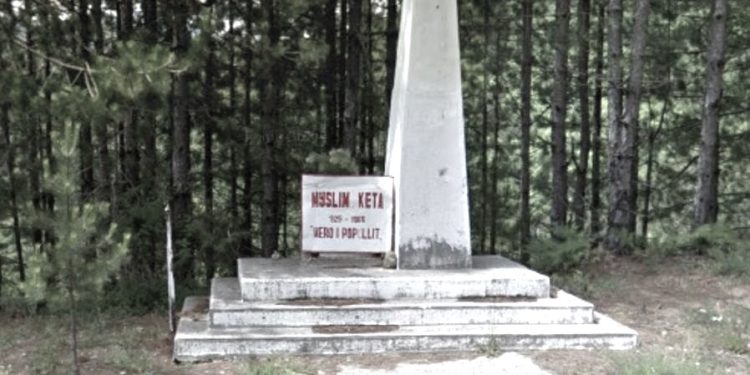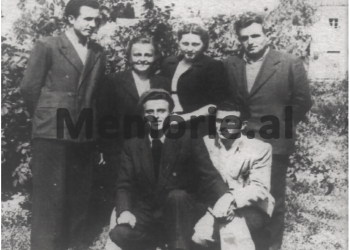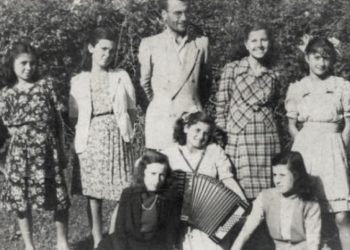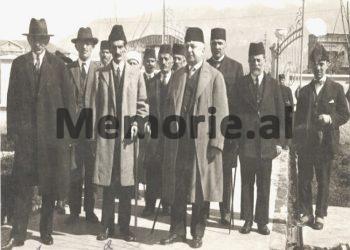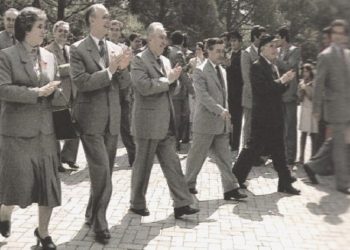From Drini Pilkati
Memorie.al / I had just written a commemorative article in the Tirana Observer newspaper, on the 50th anniversary of the murder of my unforgettable uncle, “National Hero” Myslym Keta, from the many friends I have, I received many messages of consolation and thanks for the memory of the anniversary of this popular hero of Tirana and all of Albania. With their messages, they also brought me memories of their parents, who had fought and worked alongside Lym, confirming their early suspicions about his loss. Among them was Burhan Tabaku, a professor of mathematics, with whom we had worked together for many years in the difficult district of Puka. Along with the message of condolence and thanks for this memorial letter, he also sends me the photo of a magnificent sculpture that was exactly that of my uncle, Myslym Keta, which his brother, Besimi, had realized in 1968.
I had no information about this sculpture and I was very happy about it, but along with the joy, it was common for my eyes to start watering. The memories of that day (February 25, 1966) began to come to my mind, when Lieutenant-General Abaz Fejzo, Commander of the Tank Department, came to my house that morning, who, after hugging me, took me with him down the palace. Our families lived on “Durres Street”, exactly in Merlika’s palace. Abazi had a short body, but he complemented it well, with the energy of a soldier. A new military “Gaz” (type 69) was waiting below, and in the second seat, my uncle’s little son, Ceni, was sitting.
I still had tears in my eyes, as I had lost not only my uncle, but also my idol, while I saw Ceni a little sad. It seemed that he did not know anything about what had happened, it is implied that he had not yet turned 8 years old and his reactions would be like this. While I was almost 12 years old, that’s why I gave myself the strength to refrain. I immediately wiped my tears and put my hand on Cen’s neck, as if to give him courage, but with his usual smirk, it was he who gave me courage. Surprisingly, my tears ended, as if they had been closed with a faucet, and I only remember that I did not know what to say to him. The driver started to treat us well and took us around Tirana a few times, then took us back to our homes. Later I found out that this was the time when the great uncle’s burial ceremony was taking place in “Skënderbej” Square.
This was the reason that I did not participate in his funeral, but later from the people who had come for consolation, I found out that the people of Tirana, citizens, villagers and mountaineers from all over Albania had given my uncle a truly magnificent funeral and spontaneous. Myslym Keta, was for them the “Tribune of Vigil” as these golden words of Noli sounded very beautiful even for this nationwide hero. Dictator Enver Hoxha did not want the tributes to be made in the hall of the People’s Assembly, as it belonged to him, but with the order of Abdyl Këllez, who at that time was the Chairman of the Executive Committee of Tirana, the tributes were made in its great hall. My father was also the first deputy chairman of the Executive Committee of Tirana, so it was up to him twice to organize the tributes and the funeral, the first as his brother-in-law and the second as co-owner of this institution. The body of the lifeless Muslim was placed at the Shish Tufina cemetery, which had been inaugurated for a while, in the first plot by the road, where the plot of the Keta family later became.
This is because the dictator had not accepted that Lymi be buried at the Martyrs’ Cemetery, with the excuse that he had not fallen in the War. This justification was very funny, since Myslym Keta was considered a symbol of Albanian bravery. As a result of this consideration, in April 1947, he was proposed by the Balkan Anti-Fascist Youth, at its congress in Belgrade, for the highest existing title, that of “Hero of Nations”. For the contribution they had chosen two young men; one from Albania and one from Poland and both together, Tito himself had invited them to the podium of this event. Intentionally or unintentionally, Enver Hoxha could not oppose this at that time and as a result this proposal became a reality three months later. So on July 7, at the age of 22, Myslym Keta was announced by the People’s Assembly of Albania as the first “National Hero”, forever.
I had separated from my uncle three days before he died, which was the most tragic and mysterious loss for our family. I had made it a habit after leaving the eight-year school, “Avni Rustemi”, to go once with a friend from the Central House of the People’s Army (former Union of Writers), to meet my uncle. I knew that he was often there with his friends, so I had fun bragging about him in front of my friends. It was almost the end of spring and it was unusual for that very end of February to have beautiful sunny weather, but it was just my luck that on that day I got to see my uncle for the last time. He was among his friends, in front of the door of the Central House of the Army, and I immediately recognized him from the “Republika” Cinema, as he was a head taller than his friends. His tall body, graced by a tank officer’s suit, with a long dark green jacket and light trousers, fit so beautifully on his body, as if the apostate was made for him. On his chest shone a five-pointed star-shaped emblem and above it a red and black stripe, which was the emblem of the National Hero.
Uncle!, – I say to my friend and run to meet him and my friend also runs after me. As soon as I get close, I call out: Oh come on! I realized that he had seen me too, as he was saying something to his friends about me, and they turned their heads from me at once, laughing. Without hesitating, he approached me, rubbing my head and laughingly said: “What are you doing here, come on, go to the restaurant and have lunch, because it’s late, when my uncle returns from the service, I will bring you the coat of arms that you have.” search”. To tell you the truth, I had a crush on him for a long time, because every time I met him, I asked him for that badge, but he never bothered. Late after the assassination I found out that it was the National Hero medal, which had become a real hostage for me.
The picture of my uncle’s statue, which Burhan had sent me, was the most beautiful and expensive towel he could have made me. It was very strange, that at the exact moment I was recalling him in my book, uncle Lymi appeared before me again, alive after 50 years, but this time as a real colossus. For me, this was already a new and very important episode, as it will close my book even more beautifully.
I was at my home in Italy and I was not getting bored until I returned to Tirana. I was at the end of the book, which I had dedicated to my uncle and my father, and in it I summarized the memories of their closest friends and those with secrets, which in the period of the dictatorship, were never told or written. With this thought embedded in my mind, after a while I arrived in Tirana. I definitely had to meet Burhan and his brother, Besim, as I wanted to know all about the sculpture and its fate. Burhan had told me that, together with Besim, they were trying to collect all his artistic works, among them the sculpture of the hero Myslym Keta. For this work, Besimi was extremely upset, as he had not seen it for a long time and had always had doubts that his most beautiful work had disappeared without a trace from the communist dictatorship.
Immediately the next day I called Burhan and after two days we met the three together, at the bar of the “Ali Demi” Sports Complex. It seemed very strange to me, that parallel to the murder of my uncle, his statue after two years had the same fate…! There were two mysteries and among them the first one, after a lot of fatigue, I have already managed to unravel, but this second one completely disoriented me. This showed how low the communist dictatorship had fallen and Enver Hoxha, who was not satisfied with his elimination, but had also, carried out the plans for the destruction of his statue without a trace. Besimi was a very wise, calm man, a true historian, as he had also worked for a long time at the Institute of Cultural Monuments. He told me with great interest everything I wanted to know about the history of the sculpture, patiently explaining even the smallest detail. It took another day to complete the story of the loss of this sculpture by the communist dictatorship.
Testimony of the sculptor, Besim Tabaku:
“In the years 1958-’62, I finished the Artistic High School and then I appeared in the competition that was organized for the continuation of higher studies, that of Figurative Arts in Tirana. I finished the competition successfully and for this reason, in 1963, I started my studies in the first year of this institute. Then we did practice at the “Mihal Grameno” school, at the end of the street with the same name. The hero Myslym Keta also lived on this street, which I knew closely, as he was a childhood friend of my uncle Liu (Ali Kubatin), who was my aunt’s uncle. Since their early youth, they often hung out together, as Liu at that time lived on the other side of the Lana river, (behind the “Ismail Qemali” high school), which was located about 300 meters as the crow flies, from Lymi’s nonda’s house , where he spent most of his time. Even during the War, they had met to fight together again, first in the Dajt Battalion, the 3rd Assault Brigade and its 1st Company, where Lymi was the commander and Liu, the commissar.
They have rigorously preserved this society even after the war, and Liu’s house was a second home for Lymi. As my father told me, Lymi was a daily presence in our house and had become everyone’s favorite, since at that time we all lived together. There were many occasions when I was going to school then, I often changed paths with Lymi, when he left for the ministry every morning. I had always been fascinated by the graceful appearance of this tall man, a real giant; equal to the fame he had created in Albania and the Balkans. Daj Liu had told us about his much bravery and that he had been decorated with the high title of “National Hero”. However, Uncle Liu told me that he was very simple and modest with everyone, and I had experienced this myself, when he passed by “Mihal Grameno” street, as he greeted everyone, including the Roma of Tabakhone.
Around 1965, I saw Lymi for the last time at the exhibition of the Gallery of Figurative Arts, which was organized at the Palace of the Princesses (today the building of the Institute of Political Persecutions). A bust of the “People’s Hero” Kajo Karafili and many other works on the theme of the War were exhibited there. It was there that I last saw Lym, who was staring intently at Cajo’s sculpture and was shaking his head in displeasure, telling his friends that the sculpture did not look like him. But it was also the first moment that I saw him closely and in particular his manly features, which were deeply imprinted in my mind. In 1967, I finished the Institute of Figurative Arts and started doing my first jobs, but the affirmation in this field was very difficult, since there were many famous sculptors in Tirana, among them; Odhise Paskali, Hektor Dule, Kristaq Rama, Shaban Haderi and many others. I also had the great fortune to finish a work of Shaban Hadër (“Herojnje e Vigu”) who was sick at the time and had a lot of faith in me, that I could finish it successfully.
In 1969, it was the first exhibition that I would participate in, and for this reason, I went to the League of Writers, to consult about the sculpture project, which I would present there. It was the 25th anniversary of the liberation and the works should be mainly from the National Liberation War. There I met Foto Stamon, former secretary of the League of Figurative Arts. After I consulted with him about the future work, he was the one who said to me: “O Besim, why don’t you do Heroin Myslym Keta, since you also had your tyranny and I believe that you will cry.” His words warmed me so much that in the blink of an eye, I immediately gave him a positive answer, adding that: Lymi has been the closest friend of Daj Liu (Ali Kubati) and our whole family. I explained to him that I knew him very well, every detail of his physiognomy, as I have seen him almost every day, when I went to the first year of the Institute of Figurative Arts, since he lived right on that street.
My words made a great impression on him and after patting my shoulders, Foto said to me: “With what you said to me, O Besim, we are convinced that you will really cry, the statue of Myslym Keta, come on, good luck”, and gave me hand to part. As soon as I left, my mind immediately went to the year 1965, when I last saw Myslym Keta very close alive, seeing the exhibited portrait of Kajo Karafili. He had been displeased by the resemblance to the face he remembered. He had been right, as he had been a friend in the guerilla unit, but this would not be the same for me, as I still had him alive in my eyes. I had been inspired to make the statue of Myslym Keta, since he was alive, but I did not have the opportunity, while now after his death, I was fully convinced that I lacked nothing to make it exactly. To make sure, I went to his family, where I met his wife. I told her that I am the nephew of Li Kubati and she made available to me many photos of him.
I chose among them, those photos that interested me, from my point of view as a sculptor. I decided to make Lymi a military man, as it was also the 25th anniversary of the creation of the National Liberation Army and its Headquarters at the Labinot conference. Myslymi was a tank driver and I had to make a tall statue and a special outfit, that’s why I also got a sweatshirt for Edip Ohri, the Aviation commander, who was Daj Liu’s son-in-law. Their sweaters were the same as those of the tankers. I didn’t have a studio where I could work, but the sculptor Shaban Haderi solved this for me, who made his studio available to me. I finished the modeling, cast it in plaster and as an imitation, I gave it the bronze color as the final touch.
The next morning I took her to the hall of the Palace of Culture, on the first floor, where the exhibition would open in two days. Around the sculpture of Lymi, the lighting workers often passed and I saw them acting curiously around it, as I was cleaning it. They didn’t realize that I had done it, since I was very young, but I only heard the words circulating among them: This sculptor made Lymi cry, he turned out more beautiful than Enver. The words of the maintenance workers were those of the common people, since for them Lymi represented exactly the most popular man and the feeling he created for them was different from Enver. It was natural that their compliments made me very happy, but I left it at that, as I didn’t want them to know that I had done it.
In the next column of the exhibition, next to it, the sculpture of Enver Hoxha was placed, which Odhise Paskali also made very beautifully. He was wearing the partisan uniform he had at the Labinot conference. After a while came the commission of artistic assessment, chaired by Kristaq Ramë, who was at that time the highest state authority in this field. Kristaqi himself tells me that: “You really made Lymi cry and this are a work for a medal”. The committee then left, paying me their compliments. In addition to the artistic commission, our works in exhibitions should be evaluated by another commission, but this time, political. Usually this was done by a senior leader of the state and in our case Beqir Balluku, who at that time was the Minister of Defense and a member of the Political Bureau. That morning I left the hall very satisfied and convinced by the evaluations of the most competent people in this field.
It was my first official job, which had the broad approval of the public and senior leaders. Later that day, I went to meet Foton, who willingly, reluctantly, with half his voice, told me the truth: “There is only one chance left to participate in this exhibition, only after cutting the statue of Lymi in Torst (Bust), but you, do as you like”. The statues of Enver and Myslymi were almost the same height, about 2.20 cm, and as Photo showed me, after seeing them closely, Beqir Balluku said that: “Both statues are beautifully made, but the war commander was only one, Enver Hoxha and we do not want the people to be confused about this. Therefore, the statue of Lymi should be cut as a bust, so that it can be exhibited here”.
That was all he had said and left the hall, a little red in the face. Even Kristaqi had told Foto that: It was the first time that a work so realized and liked by the commission, could not be presented in this exhibition. I understood that Foto was forced for this proposal, since it is not possible for such a famous sculptor to do such a thing. However, I couldn’t say anything to him, because the words stuck in my throat. I blushed completely and felt that only tears came out of my eyes. Everything starts spinning around me, but I remember leaving the exhibition hall in a daze and going straight home. That evening, I told the whole family what happened, who did their best to calm me down. The next morning, my father told me that he had gone to talk to Daj Liu about this and that he had told him that: “Men do not go to this exhibition.” And I did the same.
After the exhibition ended, I met my classmates, they were the ones who confirmed to me that next to the statue of Enver Hoxha, there was no longer the statue of Myslym Keta, and this did not surprise me. In its place, an equally tall statue of an anonymous pilot was placed, which was very beautifully done by the sculptor Andrea Mano. They also gave me the following photo from the exhibition, which they had removed from the stand that was displayed in the art institute. On the day of the Exhibition, Enver Hoxha himself came to the hall of the Palace of Culture, together with other senior leaders, such as; Mehmet Shehu, Beqir Balluku and Kadri Hazbiu. They had stopped more at the statue of the anonymous pilot, as for modesty and to show that he liked it more, as can be seen in the photo. After that, they approached the statue of Enver Hoxha, which Odhise Paskali had made very beautifully, who also received the award of the Republic”.
As his friends had told Besimi, Enveri had checked his sculpture very strictly and that the end had left him satisfied. But the most satisfied in this government magazine was Beqir Balluku, who had the ability to remove Myslym Keta’s statue from the exhibition in time. With this action, he avoided Enver Hoxha’s wish, since the statue of Myslym Keta no longer had any importance for him, since he was dead, and had even been betrayed by them, since two years ago. Beqiri was now sleeping peacefully and obediently, since eventually, according to him; the people would no longer have even the slightest doubt that the only leader of the National Liberation War had been only Enver Hoxha.
This was the funniest thing I’ve seen and heard to date and it couldn’t be any argument to eliminate Besim’s artwork. In fact, this increased even more the doubts about Lymi’s mysterious elimination. Despite all the effort, sweat and talent of this young artist, his first work did not enter the discussion of the press of the time, even though it was considered the most accomplished by the commission of artistic evaluation. This ugly staging could not lose the importance and popularity of a popular hero, but it was only the biggest damage that can be done to a young creator. In such an important exhibition, his work had not won the citizenship of Tirana.
Continuation of Besim Tabak’s story:
“The day after that day, I go to the Institute of Figurative Arts, where by chance I change hands in the salon with Kristaq Rama, who was also giving lectures at that time. As soon as we came face to face, he took me aside, saying in a low voice that: “You boy with character…”! I found these words very brave and strange, which gave me more courage, since Kristaqi, in addition to being a very well-known artist, at that time was the highest state authority in this field, but also the vice president of the People’s Assembly. His words gave me so much courage that I started to ask him: “Where the statue of Myslym Keta now and what is will be done with it”?!
But he laughingly answered me: “Don’t worry, it’s the same as you left it, but you’re lucky, that your work was not in vain, as we sold it to the Ministry of Defense for an expensive price, which bought it to put it in the department of Tanks in Zall-Herr”. Kristaq’s last words warmed my heart a lot, as they freed me from such great anxiety. As I understood, after all these ugly actions, for his comrade of the war, the conscience had called Beqiri, to justify the guilt committed before. Even when they had placed the statue in the Tank department, as the creator of this work, I was not called to participate. They had estimated it at 2,500 new ALL, which for me was a lot at the time, but compared to my sweat and emotions, they didn’t have the right value. The fact was that those money. I broke them for a while, to buy clothes, and they seemed to me like grapes and plums.
The only thought that came to my mind was the statue of Myslym Keta, which was no longer mine. It was locked in a place that was difficult to enter even though I was the author of it, much less for the common people. Since I had maintained my stance, it made me doubt the longevity of my job. I had the same doubt about the existence of Myslym Keta’s statue, especially after the 1980s, when the “Tirana Group” was condemned, where uncle Liu and his brother, uncle Bibi (Ibrahim Kubati) were part of that “group hostile”. I always suspected the existence of the statue of Myslym Keta, but I did not have the opportunity to prove it, since it was impossible to enter this ward. This was true, as Myslym Keta’s statue had disappeared without a trace, and along with it, my masterpiece. I proved this when I went to check on the tank department recently, but they wouldn’t let me in. For this I asked the workers who were coming out of the Ward, who confirmed my suspicion about the statue of Lymi, telling me that; he was not there and they had never seen him”!
Apart from a grave in Shtish Tufinë, which has been barbarically surrounded by unconscious villagers, today there is only one memorial for the “National Hero” Myslym Keta, which only the people of Puka dedicate to this Hero. This photo was also given to me by Burhan Tabaku, which he had photographed in Rrape of Puka, where, according to the communist dictatorship, Myslym Keta lost his life. This memorial had the opportunity to escape the barbarism of the period after the 90s, only because it was located in this village, in which during the war, the biggest battle with the Germans took place. Some barbarians had stolen and sold for iron even the chains of a tank, which were placed there as a symbolic sign, by his comrades. The lapidary was in danger of losing eventually.
Only thanks to a friend of mine, Mehmet Kadana, resident of this village, due to lack of funds, the tombstone has been partially restored, enough to remain alive there. He did this in honor of this great Hero, mine and his son, Hysen Keta, who, during the communist dictatorship, had also saved his brother from prison. This is a form of gratitude from the society and the people of Puka for me as well, who respected me immensely, as the grandson of Myslym Keta, even though my father, Sabri Pilkati, was a political prisoner from the communist dictatorship. I remember that a popular rhapsodist of this mountainous region, called Frrok Haxhia, had dedicated a song to Myslym Keta. This is a moral debt that Mehmet Kadana, Frrok Haxhia and all the people of this city have put before my conscience, but I always hope to have the opportunity to return it, at least with my commemorative writings. Memorie.al




